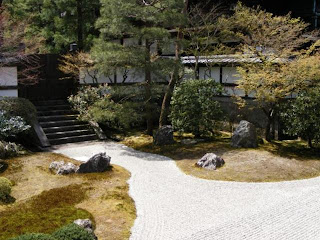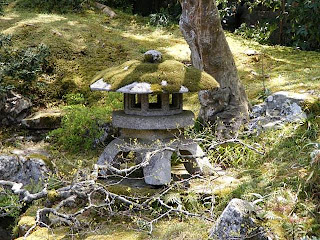Sennyu-ji is the central temple of Shingon Buddhism and it was founded in 856 by the priest Kobo. After being ruined, it was reconstructed by the Buddhist priest Shunjo, who studied in China for over 13 years. This is the reason of the Chinese influence in construction. It was the Emperor Go-Horikawa who transformed the temple into an imperial temple and so, many emperors and empresses have been burried here. Kobo also changed the name of the temple intot Sennyu-ji, which means "The Temple of the Flowing Fountain".
I try every time to bring here something new, so that the many posts about temples should not bore you, my readers. This time I would bring to your attention Gozasho, a hall for receiving guests.from the imperial family, when they come to visit the mausoleum. Very nice here are the "fusuma", the gliding door panels, painted by famous painters, like Kano Eigaku, the priest-painter. Gozasho also has a nice Japanese garden.
Unfortunately the foreign tourists do not include in their programme this temple, so all the visitors have been Japanese.
Sennyu-ji este centrul scolii Shingon de budhism si a fost fondat, se pare, in 856 de catre preotul Kobo. Desigur, la inceputuri a fost un templu mic, care a cazut in ruina. A fost insa refacut, in 1218, de catre alt preot budhist, care a studiat timp de 13 ani in China, pe nume Shunjo. Influenta stilului chinezesc al dinastiei Song este puternica. Imparatul Go-Horikawa l-a transformat in templu familial imperial si, de aceea, zeci de imparati si imparatese sunt inmormantati aici. Shunjo este cel care a redenumit templul, Sennyu-ji insemnand Templul Fantanii Curgatoare.
Incerc, de fiecare data, sa va prezint ceva nou sau deosebit la un templu fiindca, poate, altfel atatea postari despre temple vi s-ar putea parea plictisitoare.
Aici, o sala de expozitie, adapostind splendide desene si tablouri, mi s-a parut, mai intai, punctul central de interes.
Apoi, am descoperit Gozasho, o cladire care a fost parte a resedintei imparatesei, Palatul Osato (Osatogoten), si a fost mutat aici pentru a servi drept loc de odihna al familiei imperiale cand venea in vizita la mausoleul imperial. Usile glisante pictate (fusuma) de mari pictori ai vremii, cum ar fi preotul-pictor Kano Eigaku, atrag imediat atentia.
Gozasho are si o frumoasa gradina japoneza, care se foloseste, in fundal, de peisajul Muntelui Higashiyama.
Din pacate pentru ei, turistii straini nu prea includ vizitarea acestui templu (care este mult mai mare decat vedeti aici) in traseul lor. Toti vizitatorii erau japonezi.
As mai mentiona o "curiozitate" aici, Sala Dragonului Urlator (intrarea separata, 500 yen, pe langa ceilalti 500, platiti initial). O sala mare, de rugaciune, pe al carei tavan este pictat un dragon incolacit. Daca te postezi in anumite puncte sub acest dragon si bati tare din palme, se aude un fel de "racnet". E, cu siguranta o problema de acustica, dar eu nu i-am dezlegat misterul. Am fost insa unul dintre vizitatorii care l-a facut pe dragon sa racneasca!
I try every time to bring here something new, so that the many posts about temples should not bore you, my readers. This time I would bring to your attention Gozasho, a hall for receiving guests.from the imperial family, when they come to visit the mausoleum. Very nice here are the "fusuma", the gliding door panels, painted by famous painters, like Kano Eigaku, the priest-painter. Gozasho also has a nice Japanese garden.
Unfortunately the foreign tourists do not include in their programme this temple, so all the visitors have been Japanese.
Sennyu-ji este centrul scolii Shingon de budhism si a fost fondat, se pare, in 856 de catre preotul Kobo. Desigur, la inceputuri a fost un templu mic, care a cazut in ruina. A fost insa refacut, in 1218, de catre alt preot budhist, care a studiat timp de 13 ani in China, pe nume Shunjo. Influenta stilului chinezesc al dinastiei Song este puternica. Imparatul Go-Horikawa l-a transformat in templu familial imperial si, de aceea, zeci de imparati si imparatese sunt inmormantati aici. Shunjo este cel care a redenumit templul, Sennyu-ji insemnand Templul Fantanii Curgatoare.
clopotnita
Cannon Hall
Butsu-den sau Sala lui Budha
jocuri de forme si volume
Aici, o sala de expozitie, adapostind splendide desene si tablouri, mi s-a parut, mai intai, punctul central de interes.
Apoi, am descoperit Gozasho, o cladire care a fost parte a resedintei imparatesei, Palatul Osato (Osatogoten), si a fost mutat aici pentru a servi drept loc de odihna al familiei imperiale cand venea in vizita la mausoleul imperial. Usile glisante pictate (fusuma) de mari pictori ai vremii, cum ar fi preotul-pictor Kano Eigaku, atrag imediat atentia.
Din pacate pentru ei, turistii straini nu prea includ vizitarea acestui templu (care este mult mai mare decat vedeti aici) in traseul lor. Toti vizitatorii erau japonezi.
As mai mentiona o "curiozitate" aici, Sala Dragonului Urlator (intrarea separata, 500 yen, pe langa ceilalti 500, platiti initial). O sala mare, de rugaciune, pe al carei tavan este pictat un dragon incolacit. Daca te postezi in anumite puncte sub acest dragon si bati tare din palme, se aude un fel de "racnet". E, cu siguranta o problema de acustica, dar eu nu i-am dezlegat misterul. Am fost insa unul dintre vizitatorii care l-a facut pe dragon sa racneasca!




























12 comments:
Thats really nice..... good work my friend.
Wish you a nice weekend,
Greetings, Joop
Nice weekend to you too, Joop! Thanks.
I love those fountains.
Yes, they are nice, Randy.
Now I understand a little better why some Chinese-style building sits. And I am not boring you emt the beautiful pictures of the temples though. This sliding door panels are indeed very beautiful. What I like are the small ponds that I see are. Again very nice travelogue Traveling Hawk. Thank you.
Greetings, Helma
Thank you, Helma dear! Have a nice Sunday!
You witness such amazing places in your travels TH! Here i find the fountains especially interesting. Oh, and the paintings too. Well, it all looks fascinating :^)
Thanks, Doug!
Isn't it wonderful how well preserved these old places and things are? It's almost hard to believe they are as old as they say! Here one can really see the Chinese influence in both architecture and art.
This was a particular nice temple, you are right.
I love those Japanese murals and am reminded when I see the tall backed chairs about the designer Charles Rennie Mackintosh who was influenced heavily with Japanese culture at the beginning of the 20th century.
You are right, J_on_tour. The murals are amazing. It is explained that the use of nature elements was meant for the ladies, who rarely left the castles, so they only looked at the landscapes on the walls! That part of the temple was allocated for the imperial family. I have seen McIntosh chairs at the museum, in Paris:)
Post a Comment